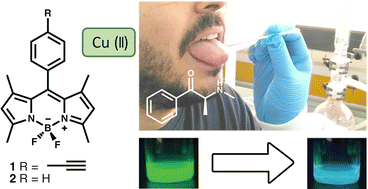Colorimetric and fluorescent detection of synthetic cathinones in oral fluid with meso-aryl BODIPYs and Cu(ii)†
Abstract
Synthetic cathinones are a class of new psychoactive substances whose consumption has increased a lot and is widespread throughout the world. Thus, there is currently a need for rapid and simple detection of these drugs. In particular, detection of synthetic cathinones in oral fluid in drivers can be of great importance in preventing traffic accidents. Herein, we report two probes, based on BODIPY derivatives combined with Cu(II), which are able to detect these drugs both in water and in oral fluid, by changes in color and fluorescence. The determined limits of detection for ephedrone (as a model drug) are lower than the usual concentrations in saliva after intake of this type of drug. The sensing mechanism seems to be related to the cathinone induced reduction of Cu(II) to Cu(I) with concomitants changes in the BODIPY structure.



 Please wait while we load your content...
Please wait while we load your content...